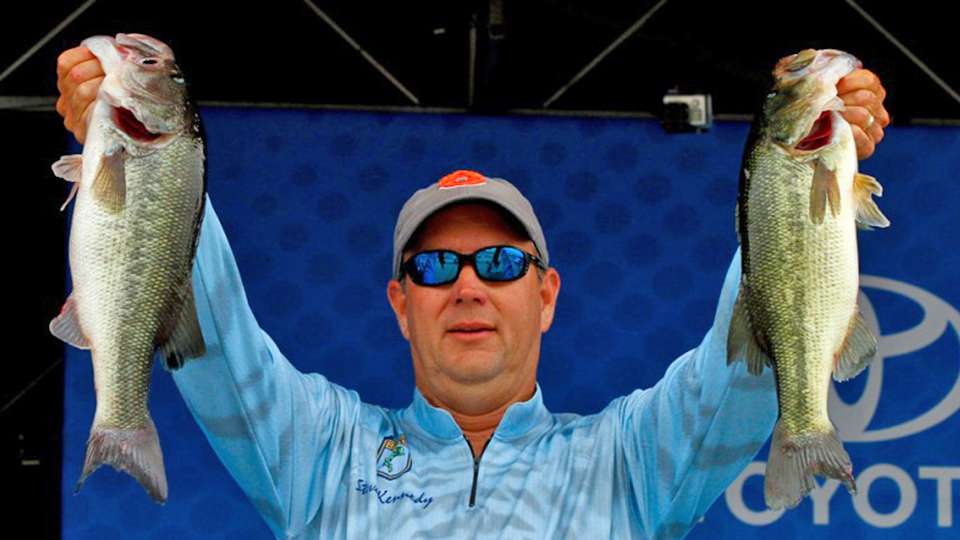
The summertime heat is still a factor, but that productive pattern of probing deep brushpiles is slowly turning off. Most summertime bass congregate on offshore structure at depths of 25 feet or more, but the deep water haunts become less reliable by late summer.
“As the summer progresses they kind of scatter a little bit,” says Steve Kennedy. “I don’t know if it’s fishing pressure, where the guys keep finding them and breaking them up a little bit, or if that’s just the normal progression.
“Typically, the fish are deeper, but, depending on oxygen levels, the fish could be shallow (1 foot or less). It is amazing how many fish you can catch in 90- to 100-degree water in 1 foot of water.” Deep cranking, Carolina rigging and drop shotting are reliable summertime techniques for Kennedy when he targets offshore fish. “I can’t say that’s my favorite way to fish,” he admits.
“I have done it a lot and do it when I need to, but it’s not my favorite way to do it.” His favorite way to catch late summer bass is to go “shallower than most guys would fish. During last month’s Forrest Wood Cup championship on Lake Lanier, Kennedy found wolf packs of cruising bass in 6 to 8 inches of clear water in the backs of pockets. “I had to get up where the boat was almost touching the bottom and then throw as far as I could to get back there,” he recalls.
“I was catching 3- to 4-pound class fish.” The Alabama Elite Series pro occasionally throws a Horny Toad or a buzz bait in the shallows to cover water quickly, but his favorite lure for cruising bass is a watermelon seed 5-inch Kinami Flash impaled on a 4/0 or 5/0 round bend offset hook.
For finicky fish, he sometimes downscales to a 4-inch Kinami Flash rigged on a 3/0 hook. Kennedy occasionally tosses his lure to a stump or other piece of shallow cover, but most of the time he targets cruising fish. “A lot of times I’m sight fishing for them,” says Kennedy, who considers bream beds a sweet spot for cruisers. “I try to avoid making a long, splashy cast.
I try to skip it in front of them to make it look like a baitfish skipping across the top of the water.” After letting his bait fall to the bottom, Kennedy makes his next move based on how the fish reacts. “Typically, I’ll let it lie there until the fish swims by.
If you move it too much before the fish gets close to the lure, you might spook the fish. Usually, with that skipping action, they’re on it before it sinks a couple of inches. I’ve seen wakes coming from 15 to 20 feet away sometimes.” Kennedy’s tackle for skipping a Kinami Flash in the shallows includes a 6-foot, 3-inch Kistler medium-heavy spinning rod and a Shimano 4000 series spinning reel spooled with 10-pound monofilament line.
When he downsizes to a 4-inch Flash, Kennedy also scales down to 6- or 8-pound-test line. Despite fishing ultra-thin clear water, Kennedy can rely on this pattern even in bright sunshine. “You would think that cloudy days would be better for this pattern, but I can’t say that’s the truth.
I’ve caught them on hot, sunny days. Maybe the sunshine puts the fish in the shadows or on the targets better to where you have a better chance of catching them.” While he prefers keying on cruising shallow bass in late summer, Kennedy admits it can be a hit-and-miss pattern. “One day I can go in there and catch 20 pounds, and the next day I go back there, and I can’t get a bite.”
Originally published August 2010





